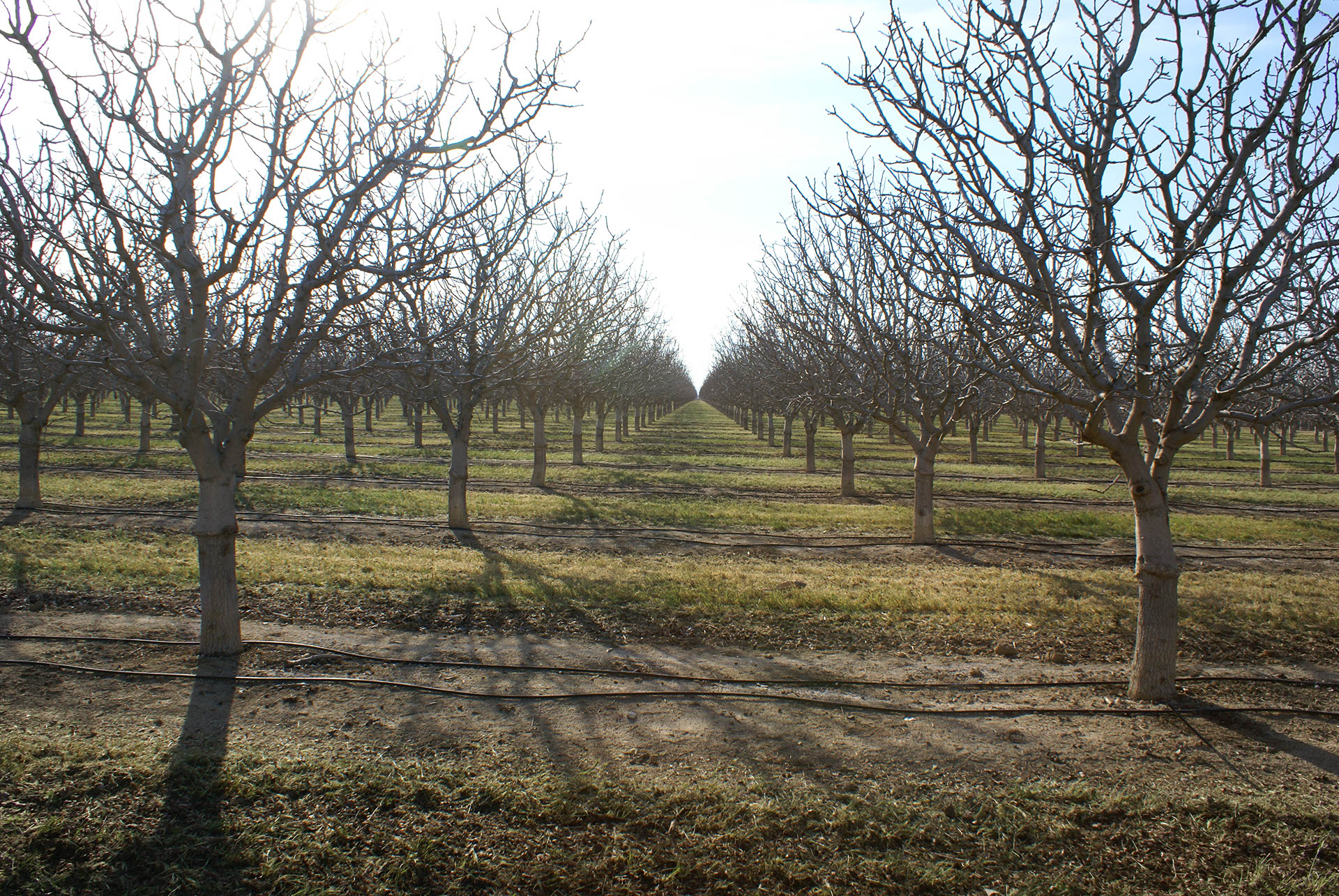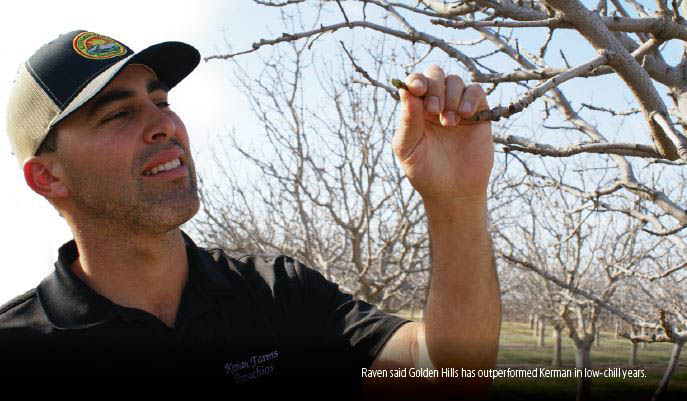It isn’t so much the good yields, the high quality and good pack out that is drawing California pistachio growers to the cultivar Golden Hills. According to Zack Raven, farm manager of Keenan Farms in Kettleman City, Calif., the big draw for Golden Hills is its early harvest.
“The number one reason why it is such a great variety is because it comes off significantly earlier than Kerman,” Raven said.
The earlier harvest, typically 10 days before the industry standard Kerman, leads to reduced susceptibility to navel orangeworm and spreads out the harvest season, Raven said. “It works for both the processor and the grower,” he said.
Released from the University of California breeding program in 2005, Golden Hills production has increased from about 3,000 acres in 2012 to approximately 65,000 acres today, making it by far the most successful variety to come along since Kerman was released in 1957.
“From what we can tell, it looks like pretty much all the new planting, with the exception of some acres going into Lost Hills, are Golden Hills,” said Dan Edward Parfitt, a retired UC Extension pomologist, who developed the variety with former UC Kern County Farm Advisor Joe Maranto.
To date, the variety appears to more than hold its own when it comes to yield. According to Raven, Golden Hills yields have topped 6,000 pounds an acre in some of his orchards, up about 500 pounds over a good-yielding Kerman orchard. And its split nut percentage is considerably higher than Kerman, he said.
“On the Golden Hills, it seems like we’re getting maybe 2 to 3 percent closed shells,” Raven said. “It is very minimal, and it is less variable than with Kerman.”
Also, Raven has seen virtually no damage in Golden Hills to the navel orangeworm, and at times has been able to reduce treatment costs by cutting out the final spray, given that Golden Hills is being harvested about the time of the pest’s final flight.
Nut size is a little smaller than Kerman, Raven said, but it is adequate. And Bob Klein, manager of the Administrative Committee for Pistachios, said he has heard processors say Golden Hills’ pack out rate is higher than Kerman’s, which can reduce transportation costs.
Growers also are finding benefits from the variety’s more upright growth trait and short branches: They are able to increase planting density, going from an average of 130 trees per acre with Kerman to 140 to 155 trees per acre with Golden Hills, and increase harvest efficiency.
“It’s canopy doesn’t go beyond the curtains of the harvesters, so everything drops straight down,” Raven said. “It makes everything a lot easier.”
The trees shorter branches also contribute to improved shaker efficiency, Parfitt said, as the energy from shakers more easily reaches branch extremities than in varieties with long branches, where a significant percentage of the shaker’s energy has expired by the time it reaches branch extremities.
Another plus for the variety is it has outperformed Kerman in low-chill years. “They don’t need as much chill as Kerman, which helps out a lot,” Raven said. “It seems like it has been low chill of late. Things are getting warmer. And this variety can help put a bandage on that issue.”
Part of the superior performance in low-chill years, Parfitt said, can be attributed to the performance of the Golden Hills’ pollinizer, Randy, which flowers much earlier than the Kerman pollinizer Peters. Some orchardists, in fact, have taken to interspersing Randy in Kerman orchards to help offset the effects of low chill on Kerman, Parfitt said.
About the only downside Raven has encountered thus far into his experiences with Golden Hills is a lack of flexibility in harvest timing.
“When it is time to harvest, you need to get in there and shake them ASAP,” Raven said. “You can’t wait another seven to ten days like you can on a Kerman. You need to get going and shake it when they are ready. If you wait on this variety, it tends to turn on you a little quicker. The nuts don’t hold onto the tree very well like a Kerman.”
In an article published in West Coast Nut magazine last August, Craig E. Kallsen, UC Cooperative Extension citrus and pistachio farm advisor for Kern County, noted that research trials have demonstrated that trees just coming into bearing will harvest later than mature bearing trees. And, because many of the older Golden Hills trees in the San Joaquin Valley are just coming into bearing or have only been bearing for a few years, they tend to harvest closer in time to older Kerman trees. “However,” Kallsen wrote, “this will not continue. A finished harvest for a mature Golden Hills orchard is completed 10 days to two weeks before a mature Kerman orchard, if growing in the same valley location.”
As for harvest timing, Kallsen wrote that Golden Hills is ready to harvest once a majority of the hulls have split.
The variety can require more post-harvest irrigation than Kerman, Kallsen wrote. “For optimal yields and if green leaves are present, continue to meet water requirements of the mature trees after harvest (which may be an additional month or six weeks),” he wrote. “Attempting to institute post-harvest regulated deficit irrigation on Golden Hills, which usually is harvested by the end of August or early September in the southern SJV, may produce yield and nut quality results quite different from the fully irrigated post-harvest trees in our small experimental trials.”
Lost Hills, which also has been generating interest among Central Valley pistachio producers, is similar to Golden Hills in many respects, according to Parfitt, including in its early maturity. Unlike Golden Hills, however, it has a larger nut size than Kerman, and its canopy and growth pattern are more similar to Kerman than Golden Hills.
“From what I’ve seen, it looks pretty good,” Raven said of his experiences with Lost Hills. “The nut is much larger. I wouldn’t say you are getting better poundage, but from what I’ve heard, you will eventually get more pounds per acre from the variety.”
Raven said the nut quality and split nut percentage of Lost Hills is similar to Golden Hills. And, as with Golden Hills, growers need to closely monitor the nut at harvest. “You have really got to pay attention,” Raven said. “Even though the hull looks a little green and doesn’t look ready to shake, if you go out there and pull them off, they are absolutely ready to go. You’ve got to pay a little more attention come harvest. Like Golden Hills, the variety won’t hold on very well; not like the Kerman.”
Gumdrop, another pistachio variety generating interest, harvests even earlier than Golden Hills and Lost Hills. “It is an interesting variety,” Parfitt said. “It is a big tree and has a good yield, and it is a little larger nut than Golden Hills.”
One issue with the variety, according to Klein, is it harvests so early that processors are reluctant to work with it because of the significant gap between its harvest and that of the Golden Hills and Lost Hills.
“They don’t seem to have a great deal of interest in it,” Klein said, “but I know there is some being planted out there.”
Breeder Gets What He Was Looking for in Golden Hills
In the late 1980s, when then UC Davis pomologist Dr. Dan Edward Parfitt set out with then UC farm advisor Joe Maranto to find new pistachio varieties, he was looking for several of the traits exhibited by Golden Hills, a variety that today is catching on in a big way with California pistachio producers.
“I was looking at different maturity dates,” said Parfitt, who retired last year but is still doing some pistachio research. “I was looking at nut size, because large nuts are always great. I was looking for low non-splits and few blanks, because those traits contribute to high grower-paid yield.”
Parfitt didn’t get the nut size he was hoping to achieve – Golden Hills nuts are slightly smaller than Kerman, the industry standard – but he was able to achieve the other traits, and there were some bonuses thrown in. For one, Golden Hills trees have a more upright growth pattern and smaller branches, which has improved harvest efficiency and increased planting density. And the variety has performed admirably in low-chill years.
Today, roughly 20 percent of the California pistachio acreage is planted to Golden Hills and more are going in all the time. Ironically, however, as Parfitt describes it, there wasn’t a big push to develop new varieties when he and Maranto started on the research.
“A lot of people in the industry really didn’t understand why we were (pursuing new cultivars),” Parfitt said, “and people in our department didn’t understand why we were doing it. Particularly our leadership was not very supportive, until it proved out. Now that it has proved out, everybody is pretty happy with what we’ve accomplished.”
Golden Hills and Lost Hills, another variety gaining in popularity among California pistachio producers, emerged as the top varieties from multiple crosses that Parfitt and Maranto analyzed in variety trials that they planted in three locations in 1988, ‘89 and ‘90.
“From that, down in the southern San Joaquin Valley, we selected nine items for testing against Kerman, and we set up a couple of advanced selection plots around 2000. From there, we ended up picking Golden Hills and Lost Hills and the male Randy. Randy was picked because we needed an early male.”
Five years later, in 2005, Golden Hills was released, and by 2012, after nurseries had built up supplies and growers were seeing promise in the variety, growers were planting the cultivar in earnest.
Rate of acceptance further accelerated after the variety significantly outperformed Kerman in the back-to-back low chill winters of 2014 and 2015.
As for split percentage and other traits he and Maranto pursued in their search for new cultivars, Golden Hills has excelled.
“Golden Hills generally have pretty high split and relatively few blanks,” Parfitt said.


















